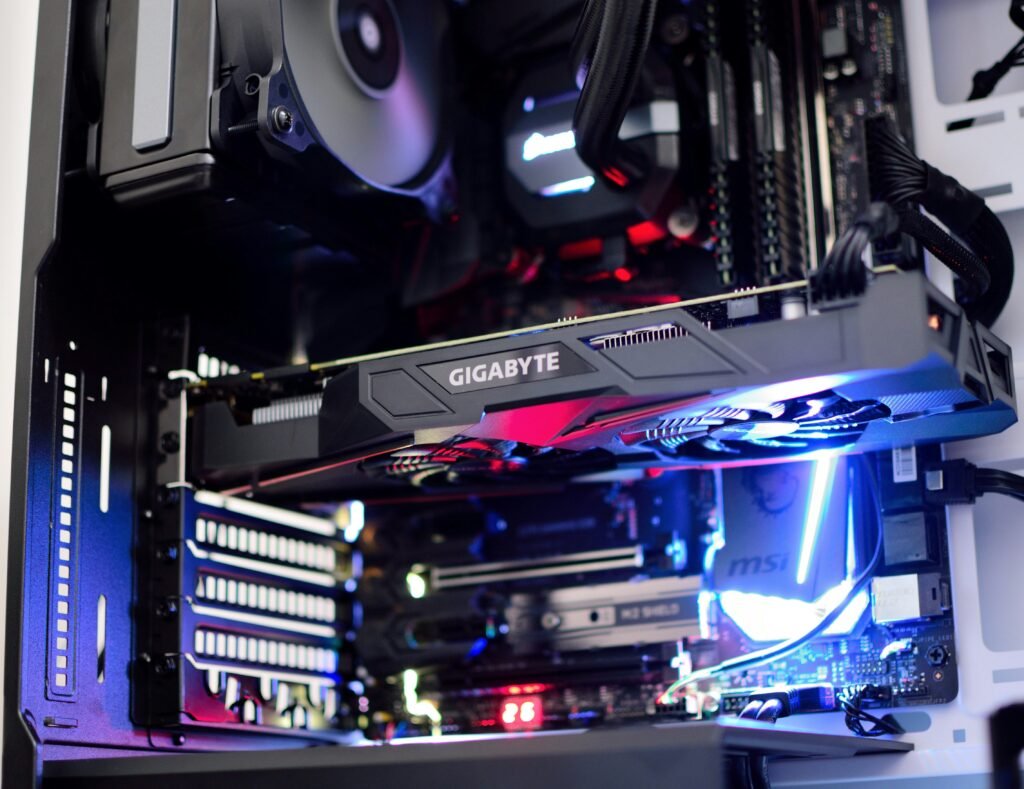The battle between Nvidia RTX 50 series vs AMD Radeon RX 9000 series took center stage at CES 2025, unveiling the most powerful gaming GPUs to date. With next-gen ray tracing, AI-driven performance boosts, and upgraded memory architectures, both Nvidia and AMD are pushing the limits of graphics technology. Whether you’re a hardcore gamer, content creator, or PC enthusiast, choosing the right GPU can significantly impact your gaming performance and workflow efficiency.
Nvidia’s RTX 50 series, powered by the Blackwell architecture, promises unmatched ray tracing and AI-driven enhancements with DLSS 4 and GDDR7 memory. On the other hand, AMD’s Radeon RX 9000 series, based on RDNA 4, delivers higher VRAM, better efficiency, and competitive pricing, making it an excellent option for those seeking value and performance.
This detailed comparison explores the key differences, specifications, pricing, and gaming performance of these next-generation GPUs, helping you decide which one is the best fit for your gaming setup. Let’s dive into the ultimate graphics showdown of CES 2025!
1. Performance & Architecture
Nvidia RTX 50 Series: Blackwell Architecture
Nvidia’s RTX 50 series is built on the cutting-edge Blackwell architecture, a successor to the Ada Lovelace-based RTX 40 series. This new 5nm process delivers improved core efficiency, faster clock speeds, and increased CUDA core count. The flagship RTX 5090 boasts over 18,000 CUDA cores and a 30% performance gain over the RTX 4090, making it the most powerful consumer GPU Nvidia has ever produced.
AMD Radeon RX 9000 Series: RDNA 4 Evolution
AMD’s Radeon RX 9000 series, powered by RDNA 4 architecture, focuses on higher efficiency, improved ray tracing, and a competitive price-to-performance ratio. The Radeon RX 9900 XT, AMD’s flagship, features a chiplet-based design that enhances bandwidth and computational power. While AMD lags behind Nvidia in raw ray tracing performance, RDNA 4 introduces enhanced AI-based upscaling and hardware-level optimizations for better gaming performance.
Performance Verdict
- The RTX 5090 outperforms the RX 9900 XT in raw computational power, making it ideal for 4K gaming and high-refresh-rate experiences.
- AMD’s chiplet-based GPUs offer impressive power efficiency and better price-to-performance ratios.
2. Ray Tracing & AI-Powered Graphics
Nvidia’s Ray Tracing & DLSS 4
Nvidia continues its dominance in ray tracing with third-generation RT cores in the RTX 50 series. The RTX 5090 and RTX 5080 deliver real-time path tracing, creating hyper-realistic lighting, reflections, and shadows. Additionally, Nvidia introduced DLSS 4 (Deep Learning Super Sampling), which now uses AI frame generation to boost FPS without sacrificing visual fidelity.
AMD’s Ray Tracing & FSR 4
AMD has significantly improved ray tracing with the RX 9000 series, narrowing the gap with Nvidia. The RDNA 4 architecture introduces enhanced RT cores, making AMD’s latest GPUs more capable of handling ray-traced workloads. AMD’s FSR 4 (FidelityFX Super Resolution) rivals DLSS 4, offering AI-based upscaling, frame generation, and performance-enhancing techniques to increase frame rates.
Ray Tracing Verdict
- Nvidia RTX 50 series still leads in ray tracing, thanks to DLSS 4 and third-gen RT cores.
- AMD Radeon RX 9000 series catches up with FSR 4, but Nvidia maintains the edge in real-time rendering and AI-driven upscaling.
3. VRAM & Memory Bandwidth
Nvidia RTX 50 Series
Nvidia has upped the VRAM game, with the RTX 5090 featuring 24GB of GDDR7 memory, offering higher bandwidth and lower latency. The RTX 5080 follows closely with 20GB of GDDR7, catering to high-end gamers and content creators.
AMD Radeon RX 9000 Series
AMD has always been generous with VRAM, and the RX 9900 XT continues the trend, boasting 32GB of GDDR6X memory. AMD’s high VRAM capacity makes its GPUs a better choice for creators, 8K workflows, and AI processing, even though Nvidia’s GDDR7 memory offers faster performance.
VRAM Verdict
- For gaming, Nvidia’s GDDR7 memory outperforms AMD’s GDDR6X.
- For creators and AI workloads, AMD’s higher VRAM capacity provides more flexibility.
4. Power Efficiency & Thermals
Nvidia’s Blackwell Efficiency
Despite its increased power, Nvidia has optimized the RTX 50 series for better efficiency, thanks to a refined 5nm process. The RTX 5090 consumes 400W, but advanced cooling solutions keep temperatures in check.
AMD’s RDNA 4 Efficiency
AMD’s RDNA 4 chips continue their power-efficient legacy. The RX 9900 XT consumes around 350W, making it a more energy-efficient alternative to the RTX 5090 while maintaining competitive performance.
Efficiency Verdict
- AMD Radeon RX 9000 series wins in power efficiency and lower thermals.
- Nvidia RTX 50 series consumes more power but offers higher performance per watt.
5. Pricing & Value for Money
| GPU Model | VRAM | Ray Tracing Performance | Power Consumption | Price |
| Nvidia RTX 5090 | 24GB GDDR7 | Best | 400W | $1,699 |
| AMD Radeon RX 9900 XT | 32GB GDDR6X | Good | 350W | $1,299 |
| Nvidia RTX 5080 | 20GB GDDR7 | Excellent | 350W | $1,199 |
| AMD Radeon RX 9800 XT | 24GB GDDR6X | Moderate | 320W | $999 |
Price Verdict
- Nvidia’s RTX 50 series is more expensive but delivers superior gaming performance.
- AMD’s Radeon RX 9000 series offers better value with high VRAM and lower cost.

Final Verdict: Nvidia RTX 50 Series vs AMD Radeon Which GPU Should You Buy?
- For 4K & high-end gaming → Nvidia RTX 50 series (Best ray tracing, DLSS 4, GDDR7)
- For budget-conscious gamers → AMD Radeon RX 9000 series (Better price-to-performance)
- For content creators & AI workloads → AMD RX 9900 XT (More VRAM, efficient performance)
Nvidia and AMD have both pushed the boundaries of GPU technology at CES 2025. If ray tracing and AI-driven performance are your priority, the RTX 50 series is the way to go. However, if you’re looking for a more affordable option with higher VRAM, the AMD Radeon RX 9000 series is a solid contender.
📌 Check out the latest GPU deals and reviews at GadgetSyte.com !

